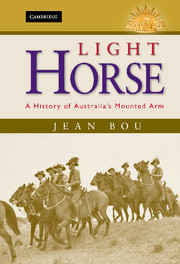Book contents
- Frontmatter
- CONTENTS
- List of maps
- ACKNOWLEDGEMENTS
- AUTHOR'S NOTE
- ABBREVIATIONS
- INTRODUCTION
- CHAPTER 1 ANCESTORS
- CHAPTER 2 TOUGH LESSONS
- CHAPTER 3 THE HUTTON ERA
- CHAPTER 4 UNFULFILLED PROMISE
- CHAPTER 5 THE LIGHT-HORSEMEN 1
- CHAPTER 6 MOUNTED RIFLES
- 7 CAVALRY
- CHAPTER 8 THE LIGHT-HORSEMEN 2
- CHAPTER 9 THE FINAL YEARS
- CONCLUSION
- EPILOGUE
- APPENDIX THE ‘BEERSHEBA CHARGE PHOTO’
- Notes
- BIBLIOGRAPHY
- INDEX
CHAPTER 4 - UNFULFILLED PROMISE
The militia light horse, 1905–20
Published online by Cambridge University Press: 05 July 2014
- Frontmatter
- CONTENTS
- List of maps
- ACKNOWLEDGEMENTS
- AUTHOR'S NOTE
- ABBREVIATIONS
- INTRODUCTION
- CHAPTER 1 ANCESTORS
- CHAPTER 2 TOUGH LESSONS
- CHAPTER 3 THE HUTTON ERA
- CHAPTER 4 UNFULFILLED PROMISE
- CHAPTER 5 THE LIGHT-HORSEMEN 1
- CHAPTER 6 MOUNTED RIFLES
- 7 CAVALRY
- CHAPTER 8 THE LIGHT-HORSEMEN 2
- CHAPTER 9 THE FINAL YEARS
- CONCLUSION
- EPILOGUE
- APPENDIX THE ‘BEERSHEBA CHARGE PHOTO’
- Notes
- BIBLIOGRAPHY
- INDEX
Summary
Looking back more than over a century later it is perhaps easy to underestimate the magnitude of the changes that Hutton had brought to the nation's military forces. A collection of quite small, parochial and disparate colonial forces had, within a few short years, been largely broken up and rearranged to conform to a new national scheme guided by a new national government working through the agency of a new national commander. This deep and thorough reform would be followed by one almost as fundamental in the years just before the First World War with the introduction of a military service scheme that was compulsory for most of the country's able-bodied males. In doing so, however, they continued to use the traditional citizen soldier (militia or unpaid volunteer) as the basis of the nation's forces. Combining this with limited defence budgets and a military scheme that owed a great deal to the sense of mission that Hutton had brought – especially for the light horse – meant that the years in the decade and more ahead of the mounted branch were to be troubled ones.
The Post-Hutton Hang-over
Hutton's efforts in Australia had not been without controversy. The government, for one, had found that dealing with a powerful and opinionated general could be difficult. Keen to broaden the sources of advice available to it, and echoing the reforms to the British Army's control then being undertaken, which led to the creation of the Army Council, it decided it would not replace Hutton. Instead they opted to create a committee to be known as the Military Board of Administration, which would, with the exception of an interregnum during the Second World War, oversee the army's administration and advise the government until the mid-1970s.
- Type
- Chapter
- Information
- Light HorseA History of Australia's Mounted Arm, pp. 87 - 114Publisher: Cambridge University PressPrint publication year: 2009

